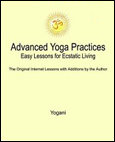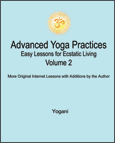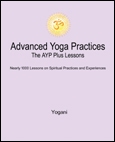|
Public Home | Plus Home | Main Lessons | Tantra Lessons | Public Forum | Plus Forum | Downloads | Books Topic Paths | Search | Training-Retreats | Testimonials | Survey | Interviews | MultiMedia | Contact | Donate |
|
Advanced Yoga Practices Note: For the Original Internet Lessons with additions, see the AYP Easy Lessons Books. For the Expanded and Interactive Internet Lessons, AYP Online Books, Audiobooks and more, see AYP Plus. Lesson 209 - Fitting Daily Practices into a Busy Schedule (Audio)
AYP Plus Additions:
From: Yogani New Visitors: It is recommended you read from the beginning of the web archive, as previous lessons are prerequisite to this one. The first lesson is, "Why This Discussion?"
So, no matter what our approach or level of attainment is, reaching our destination in a reliable fashion depends on having daily spiritual practices firmly in place. This was emphasized in these lessons with the first instructions on deep meditation, and with many reminders since then. Way back in the lessons on meditation and spinal breathing, some suggestions were given on how to fit these practices into a busy schedule. Wherever we may be, we can close our eyes and meditate - in trains, airplanes, waiting rooms, just about anywhere. The same is true of spinal breathing. In fact, light spinal breathing can be done with eyes open while on the way home from work in the car, without taking our attention off our driving. So, by the time we are home we can go right into meditation. It is not ideal practice, but can be done if the clock is pressing us at home. If we are willing to be flexible and compromise on our practices from time to time, we can keep up the habit under the most adverse circumstances. There is great value in this, for it assures us of a continuation of practices over the long term, which is the key to enlightenment. We do not live in an ideal world. Even with the best plans for regular practice in our meditation room, it can all go out the window with a family emergency or other intervening events. Does this mean our daily practices have to go out the window too? Not if we have a strategy. That is what we will cover in this lesson. Ways to keep our practices going, no matter what is happening. As our routine of yoga becomes more sophisticated, involving more practices, keeping it all going in a busy schedule presents both challenges and opportunities. With so many pieces to work with in an advanced routine, we can be pretty creative in compressing our practices when time is short. Where there is a will, there is a way! Let's talk about the basics of establishing and keeping a habit of doing daily spiritual practices. One of the easiest ways to do it is make a rule for ourselves that we will do our routine before we eat breakfast and dinner - twice a day like that. If the time of one or both of those meals isn't stable, then we can tag it to be done upon awakening in the morning, and as soon as we arrive home in the evening. If we are traveling, it gets a bit more complicated, but practices can be done to some degree under just about any circumstances, as long as we honor our habit. Keeping the habit is not only about doing a full routine. It does not have to be "all or nothing." The habit is an urge we build into ourselves to do something about spiritual practice at the appointed time that comes twice daily. Having the habit is having the "urge to practice." This cultivated urge is the seed of all daily practice. It is like getting hungry at meal times. It just happens, and we want to eat. If we have the urge for spiritual practices cultivated like that, then we will do them. Most days we will be doing our whole routine. On other days, we may be doing less. But we will always be doing something every session. This "always doing something every session" is very important. To illustrate what we mean by having the "habit," let's suppose we are hurrying down a busy street. We are on our way to a business dinner appointment that will tie us up until bedtime. We are walking quickly, weaving our way through the people we are passing on the sidewalk. The restaurant is just around the corner now. Almost there. But wait! We see a bench, an empty bus stop bench on the sidewalk in the middle of all the people hurrying this way and that way. We have that urge built into us to do practices. It is time. So what do we do? We stop and sit on that bench for a few minutes and meditate. It might be only for two minutes. But why not? Who will miss us for those two minutes? And we have kept our habit to sit. It is amazing how doing something small like that can renew us for an entire evening - centering for just a few minutes, picking up the mantra just a few times. The nervous system says, "Thank you!" And we are calmer for the rest of the evening. But it is not just about centering for a few minutes. It is also about keeping our habit of twice daily practices. If we are in a crazy schedule for days or weeks like that, and can just sit for a few minutes before breakfast and dinner, then when we recover control of our schedule we won't be struggling to find our practice routine again. The habit will be there, and then we can indulge it with our full routine, which we know will fill us to overflowing with inner silence and divine ecstasy. So that is the first thing, you know - keeping the habit, even if it for two minutes on a bus stop bench. It does not matter where it is, or what is going on. We can keep the habit if we are committed. Then it will keep us committed, because it becomes a hunger that comes on its own at the appointed time. Then we will not have to struggle to restore our commitment to yoga once we are free to do twice-daily full routines of practice again. It is more likely that we will be faced with compromises in our practice time that are not usually as extreme as having to take a few minutes on a bus stop bench. Let's talk about those. If we are doing spinal breathing and meditation, followed by a few minutes of rest while coming out, it is not difficult to tailor our practice to a time limitation. Say we are doing 10 minutes of spinal breathing, 20 minutes of meditation, and 5 minutes of rest. That is a 35 minute routine. Then one day we may find ourselves with only 15 minutes to work with. We can just do 10 minutes of meditation, rest for a few minutes and get up. We can also put a few minutes of spinal breathing in front. If we know we will be short on time, we can start with some light "walking" spinal breathing before we get to our seat. If we have to choose between spinal breathing and meditation, we always choose meditation. One thing we do not do is combine spinal breathing and deep meditation at the same time. The reasons for that are discussed early in the lessons. Let's suppose we are doing a "full plate" of practices -- everything in these lessons to a moderate degree. So let's lay it out. It is a typical routine. If you are doing more or less of any of the practices, then you can make the necessary adjustments in translating the suggestions on what to do when the schedule crunch hits you. The idea is to develop some strategies that will enable us to keep our routine together when time is short. Think about it in advance - "What will I do if my practice time is cut in half?" There is no absolute right or wrong answer. Beyond a few basics, keeping practices going when time is short is an art. So here is our moderate "full plate" routine:
Asanas - 10 min That is about 75 minutes - an hour and fifteen minutes. There is nothing sacred about the times in this routine. Maybe you are doing 15 minutes of spinal breathing, and no samyama. Or maybe no asanas. Maybe no spinal or targeted bastrika. Whatever the combination is, it is up to you. Just make sure you are not skipping meditation or rest. Those two (cultivation of inner silence, plus a stable transition to daily activity) are the foundation of all spiritual progress. Spinal breathing is right behind meditation and rest in importance. So, spinal breathing, meditation, and ending rest are a powerful and full routine of practices. All the rest of the practices are for enhancing and building on the effects of these. Note: Increasing Spinal Breathing, Meditation or Samyama more than 5-10 minutes above the amounts above, or increasing any of the energy-related practices more than 5 minutes, could lead to uncomfortable symptoms of overdoing. This would be outside the AYP baseline system. See Lesson 384. This "pecking order" is what we use as a guideline when we begin compressing our practices into a tighter schedule. So, let's say we have this wonderful one-hour-plus practice routine, and all of a sudden due to circumstances beyond our control, we find ourselves with only thirty minutes to do our afternoon routine. Without a plan, the inclination might be to just bag it for the afternoon and try again tomorrow. All or nothing, you know. That is not a good strategy. Not only will we lose the benefit of a skillfully compressed routine, but we will also dilute our habit to practice twice daily. The urge to practice needs twice daily reinforcement. Just remember the bus stop bench. If it was good enough to keep the habit going, isn't thirty minutes in a relatively quiet room a luxury? It really is. So here are some suggestions on what we can do. First, we hang on to meditation. That is always the first priority. But we'd like to do some of the other practices too, so let's trim the meditation to 15 minutes in this 30 minute plan. We know we need up to five minutes of rest at the end for a smooth transition back into activity, so that is 20 minutes, leaving us with 10 minutes to work with. Next is spinal breathing. We can do five minutes of spinal breathing in front of meditation and then use the last five minutes for other things. Which practice should the last five minutes be for? At this point, it depends on our preference. If we love our samyama, then we can go for five minutes of that and leave asanas, chin pump, spinal bastrika, and yoni mudra for tomorrow. Or, if we want chin pump and spinal bastrika, there is a trick we can do. We can marry spinal bastrika and chin pump together for three to five minutes - that is doing spinal bastrika while doing the chin pump at the same time. It is not ideal, but it provides a combined injection of bastrika and chin pump. Two for the price of one, you know. With this scenario, we are giving up the kumbhaka in chin pump, and probably won't have time for yoni mudra either. It is also possible to incorporate chin pump into the last few minutes of spinal breathing. You will recall that this is called "chin pump lite." Additionally, in less than one minute before we sit for practices, we can do a "sun salutation- style" stretching routine that includes bending back, twisting left and right, and bending forward and touching toes. A little uddiyana and/or nauli can be done also. All of the elements of an asana routine can be touched on in this way in about a minute. It is far from optimal, but it is something in the asanas department we can do before we sit. So, in this way, we can do a pretty good routine in 30 minutes if we are faced with a time limit like that. It can be done in less time too. Of course, then we are dropping more practices off. But we can always do something, even if it is sitting on a bus stop bench for a few minutes, picking up the mantra and dipping into pure bliss consciousness. Is should be mentioned that we don't have to give up any of the "parallel" practices we do while sitting. These are siddhasana, mulabandha/asvini, sambhavi, uddiyana/nauli, and kechari. To the extent we are practicing these, they can always be incorporated with our core sitting practices in every session, no matter how short the time is. Indeed, they will be found creeping into our everyday activity as ecstatic conductivity is coming up in our nervous system. By then, mudras and bandhas have become part of our normal neuro-biological functioning, and we will never lose them. Of course, we have to be mindful about practices we are doing in public view. Doing full-blown chin pump in a busy airport waiting room could lead to a call for the rescue squad. Either that or an exorcist! A vigorous bastrika session might lead to a similar call. But most of our practices can be done discreetly. That certainly applies to light spinal breathing, meditation, samyama, mulabandha, mild uddiyana/nauli, and kechari. Sambhavi is not noticeable if done with eyes fully closed, which is recommended anyway. Even siddhasana can be done discreetly in a public place if one shoe is removed and our heel is slipped up under our perineum. Sometimes where we happen to be will determine what practices we will do. As the old saying goes - "Discretion is the better part of valor." There are many ways to piece together practices if we are faced with a short schedule, or less than ideal location. After spinal breathing, meditation, and ending rest are taken care of, it is up to our personal preferences. Give it some thought. When the need arises, we can find interesting and creative ways to keep our practices going. With bhakti, we will find a way. In this busy world, we will all be faced with the challenge of having limited time for our practices. As we continue with yoga, our spiritual desire (bhakti) will become stronger, and we will find ways to keep the necessary time available. Even so, there will be things that come up occasionally that will limit our time, so it is wise to develop an attitude of flexibility and a willingness to compromise when necessary to make sure that we are always honoring our habit to practice twice each day. If we do that, there won't be much in this world that can keep us from reaching our divine destination. The guru is in you. Discuss this Lesson in the AYP Plus Support Forum Note: For detailed instructions on building a balanced daily practice routine with self-pacing, see the Eight Limbs of Yoga Book, and AYP Plus.
|
|
|
|
Join the Mail List:
AYP Retreats
eBooks - PDF, EPUB
FREE eBooks with
SAVE with Bundled
|

























